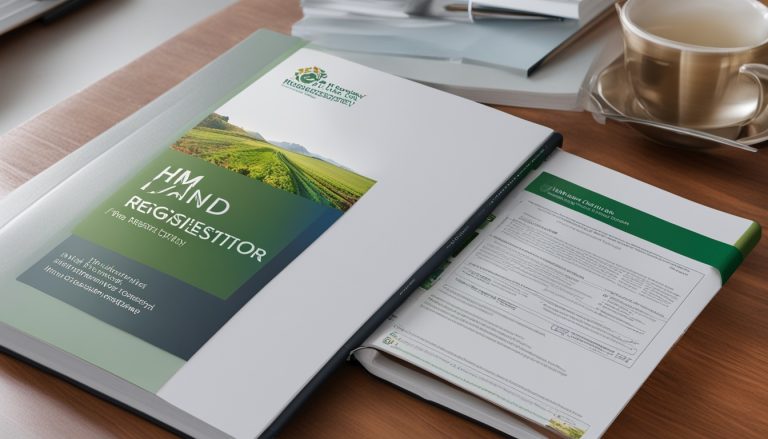Accurate property boundaries, streamlined conveyancing processes, and the avoidance of costly disputes – these are the key benefits of land registry compliant plans. These plans provide a clear and legally binding representation of the extent of a property, playing a crucial role in property transactions and land registration. Preparing land registry compliant plans involves adhering to specific guidelines and requirements set out by the UK Land Registry, ensuring the plans can be easily identified and integrated into the conveyancing documentation.
This article will explore the importance of land registry compliant plans, the legal and physical definitions of boundaries, the challenges in precisely depicting boundaries, and the various application-specific requirements for plan preparation, as well as the use of verbal descriptions and the conclusion.
Understanding Land Registry Plans
Navigating the complexities of land boundaries and their representation on official plans is a crucial aspect of property ownership and transactions. At the heart of this understanding lies the distinction between legal boundaries and physical boundaries, as well as the inherent challenges in depicting these with precise accuracy on land registry plans.
Definition of a Legal Boundary
A legal boundary is an imaginary or invisible line that divides one person’s property from another, without any physical thickness or width. The exact position of a legal boundary can only be determined by a court or the Land Registration division, as it is a matter of legal interpretation and documentation.
Definition of a Physical Boundary
In contrast, a physical boundary is a visible feature, such as a fence, wall, or hedge, which may or may not coincide with the legal boundary. These physical boundary features are often used as a reference point, but their precise position may not always align with the underlying legal boundary.
Difficulties in Showing Precise Boundaries on Plans
Accurately depicting the precise position of physical boundaries on land registry plans can be challenging due to the limitations of Ordnance Survey mapping and survey accuracy. Additionally, the potential movement of living boundary structures, like hedges, over time can further complicate the representation of boundary features on official plans.
Identifying the Position of Legal Boundaries
The position of the legal boundary is primarily determined by the terms of the relevant pre-registration conveyances or transfers, including any accompanying plan. However, in situations where the plan is unclear, the court can refer to extrinsic evidence, such as the physical features on the ground at the time, to determine the reasonable layperson’s understanding of the land being bought or sold.
Interpreting Pre-registration Conveyances
The pre-registration conveyance or transfer documents, and any plans attached to them, play a crucial role in boundary identification and determining the legal boundary position. These documents provide the legal basis for understanding the extent of the property and its boundaries.
The Role of Physical Features
Physical features on the property, such as fences, walls, or hedges, can provide an indication of the occupied extent or general position of the legal boundary. However, due to survey limitations, the precise position of these physical features may not be accurately recorded on the plan, making it essential to consider the extrinsic evidence alongside the conveyance documents.

By carefully interpreting the pre-registration conveyances and examining the physical features on the ground, the position of the legal boundary can be more accurately identified, ensuring the integrity of property transactions and land registration processes.
General Boundaries
The majority of registered titles in the UK show only the ‘general boundaries’ under section 60(1) of the Land Registration Act 2002. This means that HM Land Registry completes the first registration without making detailed enquiries about the precise location of the legal boundaries, instead relying on a reasonable interpretation of the pre-registration deeds in relation to Ordnance Survey mapping.
Reasonable Interpretation of Deeds
The position of the legal boundary is determined by the terms of the relevant pre-registration conveyance or transfer, including any accompanying plan. If the plan is unclear, the court can refer to extrinsic evidence, such as the physical features on the ground at the time, to determine the reasonable layperson’s understanding of the land being bought or sold.
No Standard Tolerance for General Boundaries
Unlike the tolerances applied to Ordnance Survey mapping, there is no standard tolerance, measurement, or ratio that can be attributed to the relationship between the position of the general boundary on an HM Land Registry title plan and the position of the legal boundary. This means that the exact location of a general boundary may not be precisely defined.
Boundary Agreements and Determined Boundaries
While general boundaries are effective for the majority of registered titles, there are occasions when a property owner may require a more precise solution. In such cases, two options are available: boundary agreements and determined boundary applications.
Boundary Agreements
Boundary agreements involve the agreement of adjoining owners to precisely identify and register the position of the legal boundaries, either in part or across the entire title extent. This process provides a more definitive solution than the general boundaries typically shown on a registered title plan.
Determined Boundary Applications
Determined boundary applications also almost invariably require the agreement of adjoining owners. These applications allow for the precise identification and registration of the position of part or the whole of the title boundaries, offering a more conclusive resolution than the general boundaries approach.
Both boundary agreements and determined boundary applications facilitate the accurate identification and registration of property boundary agreements, ensuring clear determined boundaries and helping to avoid potential boundary dispute resolution issues during land registration processes.
Ownership and Maintenance of Boundaries
There are various beliefs about how the construction of a wall or fence might indicate boundary ownership, but these have no legal foundation. Deeds may contain covenants requiring the maintenance of a boundary, but this alone does not confer ownership. Where the ownership or responsibility for maintenance of a boundary cannot be determined, the boundary is generally best regarded as a party boundary, and any alterations or replacement should only be done with the agreement of the adjoining owners.
The land registry register will only show information concerning the ownership and/or maintenance of boundary features when this information is specifically referred to in the deeds lodged for registration.
The Party Wall Act 1996
The Party Wall etc. Act 1996 regulates the manner in which works to party walls and other boundary works are carried out. This Act does not affect the property rights of land ownership, but it does provide that the owner who has carried out the works remains the owner of those works until the neighbour pays a share of the costs.
It is important to note that HM Land Registry cannot offer advice about the Party Wall Act 1996. Property owners should seek guidance from appropriate professionals, such as solicitors, licensed conveyancers, or surveyors, to ensure they fully understand their rights and responsibilities under this Act.

The Party Wall Act 1996 plays a crucial role in managing boundary works and maintaining property rights between neighbouring properties. By understanding and adhering to the requirements of this Act, property owners can ensure that any necessary works are carried out in a legally compliant and amicable manner, avoiding potential disputes or complications.
Accretion and Diluvion for Non-Tidal Rivers and Streams
The doctrine of accretion and diluvion recognises that where land is bounded by non-tidal rivers and streams, the forces of nature can cause gradual and imperceptible changes in the boundary between the land and the water. As the watercourse changes naturally and progressively over time, the land boundary follows it. These boundary changes due to accretion and diluvion are particularly relevant for non-tidal rivers and streams.
Accretion refers to the gradual and imperceptible addition of land to a property through the gradual deposition of soil or silt by the action of the water. Conversely, diluvion is the gradual and imperceptible loss of land through the removal of soil or silt by the action of the water. These natural processes can significantly impact the position of property boundaries over time, as the land boundary adjusts to follow the changing course of the non-tidal rivers and streams.
It is important to note that the doctrine of accretion and diluvion only applies to gradual and imperceptible changes in the watercourse. Sudden or dramatic changes, such as those caused by avulsion (the abrupt abandonment of a watercourse), do not result in a change to the property boundary, which remains fixed at its previous location.
Understanding the principles of accretion and diluvion is crucial for property owners and conveyancing professionals when dealing with land that is bounded by non-tidal rivers and streams. These natural processes can have a significant impact on the position of property boundaries, and it is essential to consider them when conducting surveys, preparing plans, and ensuring the accuracy of land registration records.
Land Registry Compliant Plan
Good quality, land registry compliant plans are essential for securing accurate property boundaries, streamlining conveyancing processes, and avoiding costly disputes. Plans lodged with HM Land Registry applications must comply with specific guidelines to ensure they are fit for purpose.
Importance of Good Quality Plans
Preparing land registry compliant plans is crucial for property owners and professionals involved in conveyancing, as these plans provide a clear and legally binding representation of the extent of a property. By adhering to the required standards, these plans can be easily integrated into the conveyancing documentation, facilitating efficient transactions and avoiding potential boundary disputes.
Guidelines for Preparing Plans
Plans submitted to HM Land Registry must be drawn accurately to a stated scale, show the orientation with a north point, and include sufficient detail of surrounding features to enable the property to be clearly identified on the Ordnance Survey map. Importantly, plans must not be marked as ‘Draft’, ‘For identification only’, or ‘Do not scale from this drawing’.
E-Lodgement of Plans
In addition to the plan preparation guidelines, e-lodgement of plans is an option that can further streamline the registration process. By submitting plans electronically, the time and cost associated with physical document handling can be reduced, resulting in a more efficient and convenient registration experience.
Plans for Specific Applications
The guidelines for preparing plans are fundamentally the same across different application types, but with some variations. For
first registrations
, a plan is usually necessary to clearly identify the land, unless the property has a clear postal description and is shown on the Ordnance Survey map with well-established, fully defined boundary features.
When
transferring or leasing part of a registered estate
, a plan showing the land being transferred or leased is typically required, and it must be based on the current approved version of any existing estate plan. Registrations of
unusual extents of land
, such as airspace, roof-space, tunnels, or strata, also require plans that can accurately depict the specific inclusion or exclusion of these elements in relation to existing ground surface detail.
Using Verbal Descriptions
In certain circumstances, a verbal description may be sufficient to identify the land without the need for a plan, such as for a property with a clear postal address and well-defined boundary features shown on the Ordnance Survey map. However, a verbal description alone is generally inadequate if there is any uncertainty about the land identification included, for example, in the case of open plan frontages, access ways, or outbuildings. For most property transfers and leases, a plan will be necessary to ensure the land can be clearly identified on the Ordnance Survey map.
Conclusion
Land registry compliant plans are pivotal in securing accurate property boundaries, streamlining conveyancing processes, and avoiding costly disputes. These plans must adhere to specific guidelines set out by the UK Land Registry, ensuring the land can be clearly identified and integrated into the conveyancing documentation.
By understanding the legal and physical definitions of boundaries, the challenges in depicting them, and the application-specific requirements for plan preparation, property owners and professionals can ensure that land registry compliant plans are used effectively in property transactions and land registration. This comprehensive approach helps to maintain the integrity of property boundaries, facilitates seamless conveyancing, and mitigates the risks of boundary-related conflicts.
Ultimately, the meticulous use of land registry compliant plans is essential for safeguarding property ownership, simplifying boundary planning, and supporting the efficient transfer of land and real estate in the United Kingdom. As the property market continues to evolve, the importance of these plans will only continue to grow, underscoring the need for property owners and professionals to prioritise their use in all relevant transactions and land registration processes.
FAQ
How are legal and physical boundaries defined?
A legal boundary is an imaginary or invisible line dividing one person’s property from another, with no physical thickness or width. In contrast, a physical boundary is a visible feature such as a fence, wall, or hedge, which may or may not coincide with the legal boundary.
What are the challenges in depicting precise boundaries on plans?
Accurately depicting the precise position of physical boundaries on plans can be challenging due to the limitations of Ordnance Survey mapping and survey tolerances, as well as the potential movement of living boundary structures like hedges over time.
How are the positions of legal boundaries determined?
The position of the legal boundary is determined by the terms of the relevant pre-registration conveyance or transfer, including any accompanying plan. If the plan is unclear, the court can refer to extrinsic evidence, such as the physical features on the ground at the time, to determine the reasonable layperson’s understanding of the land being bought or sold.
What are general boundaries, and how are they used?
The majority of registered titles in the UK show only the ‘general boundaries’ under section 60(1) of the Land Registration Act 2002. This means that HM Land Registry completes the first registration without making detailed enquiries about the precise location of the legal boundaries, instead relying on a reasonable interpretation of the pre-registration deeds in relation to Ordnance Survey mapping.
What are boundary agreements and determined boundary applications?
Boundary agreements require the agreement of adjoining owners, while determined boundary applications almost invariably also require this. These processes allow for the precise identification and registration of the position of part or the whole of the title boundaries, providing a more definitive solution than general boundaries.






